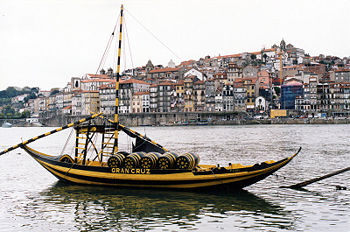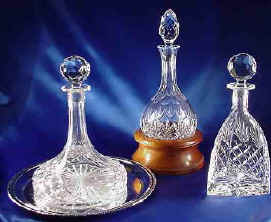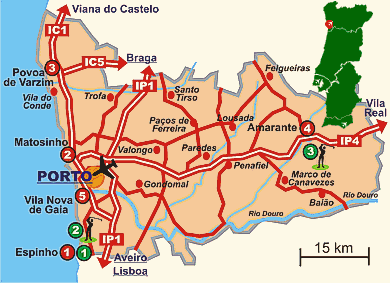By Louis S. Luzzo, Sr.

To me, there is no better after dinner apéritif than a good port. I have been a fan for quite some time. The older and dryer the better. Elegant yet bold, a good glass of port, or porto, or whichever moniker you prefer, is the perfect ending to a great meal. Come with me on an exploration of Port wine and its history.
Port Wine
Portuguese, fortified wine from the Douro Valley, Port wine, also known as Vinho do Porto, Oporto, Porto, and often simply Port, is produced in the northern provinces of Portugal.
Port is produced from grapes grown and processed in the Douro region.The addition of a distilled grape spirits (aguardente similar to brandy) then fortify the wine in order to stop the fermentation, leaving residual sugar in the wine and to boosting the alcohol content. It is then stored and aged in  barrels that are stored in caves (Portuguese meaning "cellars").
barrels that are stored in caves (Portuguese meaning "cellars").
Port wine is typically richer, sweeter, heavier, and possesses a higher alcohol content than most other wines. It is commonly served after meals as a dessert wine, often with cheese; commonly stilton. White and tawny ports are often served as an apéritif. It is typically a sweet wine but also comes as a dry or semi-dry as well.
Wines in the style of the Portuguese product called port are produced in Australia, South Africa, India, Canada, Argentina as well as the United States. European Union guidelines are quite clear that only the product that actually comes from Portugal may be called and labeled as Port. In the United States, Federal law states that the Portuguese-made product be labeled Porto or Vinho do Porto.
 The wine received its name, "Port," from the seaport city of Porto, at the mouth of the Douro River, where much of the product was brought to market or for export to other countries in Europe from the Leixões docks in the latter half of the 17th century. The Douro valley was defined and established as a protected region, or appellation in 1756 making it the oldest defined and protected wine region in the world.
The wine received its name, "Port," from the seaport city of Porto, at the mouth of the Douro River, where much of the product was brought to market or for export to other countries in Europe from the Leixões docks in the latter half of the 17th century. The Douro valley was defined and established as a protected region, or appellation in 1756 making it the oldest defined and protected wine region in the world.
Traditionally, the wine was taken downriver in flat-bottom boats called rabelos, to be stored in barrels in cellars in Vila Nova de Gaia, just across the river from Porto. During the 1950s and 1960s, several hydroelectric power dams were built along the river, ending this traditional conveyance down the river. Currently, the wine is transported from the vineyards by tanker trucks.
Port from Portugal comes in several styles, which can be divided into two broad categories:
Wines that have matured in sealed tanks or bottles, with no exposure to air, and experience what is known as "reductive" aging. This process leads to the wine losing its color very slowly and produces a wine which is smoother on the palate and less tannic.
Wines that have matured in wooden barrels, whose permeability allows a small amount of exposure to oxygen, and experience what is known as "oxidative" aging. They too lose color, but at a faster pace. If red grapes are used, in time the red color lightens to a tawny color - these are known as tawny ports They also lose volume to evaporation, leaving behind a wine that is slightly more viscous and intense.Tawny ports are wines made from red grapes that are aged in wooden barrels, exposing them to gradual oxidation and evaporation. As a result, they gradually mellow to a golden-brown colour. The exposure to wood imparts "nutty" flavours to the wine, which is blended to match the house style.
Types of Port
Ruby Port
Ruby port is a blend from several harvests, different years and different quintas. It spends a minimum of two years in very large vats before being bottled. The large vats minimize the amount of air that comes in contact with the wine, which reduces oxidization so the wine retains its bright red hue. Ready to drink when it is bottled, it has a rich red color and a full fruity taste. Ruby port is the cheapest and most extensively produced type of port. The wine is usually blended to match the style of the brand to which it is to be sold. The wine is fined and cold filtered before bottling, and does not generally improve with age. It is aged for about 3 to 5 years from wines of two or three different vintages.
Tawny Port
A Tawny port is also a blend from several harvests but is aged for two to seven years in casks.The smaller storage vessels allow more oxidization than the vats used for Ruby ports. It is ready to drink as soon as it is bottled. As its name implies, Tawny port has a deep mahogany colour, with a drier and nuttier taste.
Aged Tawny Port
Aged Tawny is the best Tawny port. It can have an age of 10, 20, 30 or more than 40 years.The age will be indicated on the label and describes the average age of the wines in the blend. In a twenty year old aged Tawny, there may be some ports 100 years old to add a complexity to the wine. Aged Tawny port has a refined, subtle taste.
Colheita Port
A Colheita (pronounced "call yay ta" which means "harvest") is a Tawny port made with grapes from a single harvest. It is aged at least seven years in casks - or "in wood" - but is usually aged much longer. Some port wine houses have Colheitas for almost every year, dating back to the past two centuries.
White Port
White ports have a lighter taste and vary from quite sweet to very dry. The sweetest are called lagrima. White port is made from white grapes, and should always be served cool or cold. It can be used as the basis for a cocktail, or served on its own. There is a range of styles of white port, from dry to very sweet. These wines are made from a blend white grapes from different vineyards and different quintas and may have a small amount of juice from red grapes. The wine spends two to three years in casks and is ready to drink when it is bottled. White port is usually served as an aperitif and makes a very tasty and refreshing drink called a Portsplash or Portonic (mix of half white port, half tonic water, ice and a twist of lemon)
Crusted Port
Crusted port is a type of Ruby and spends three years in a cask but most of its ageing is in a bottle. It is a blend of wines from several different years and gets its name from the sediment that appears in the bottle as the wine ages, since the wine is not filtered. This crust is mainly tiny pieces of grape skin plus bits of seed and stems that settle in the lowest part of the bottle. Sediment does not taste or feel good so th e port must be decanted
Vintage Character
Vintage Character port is a higher quality Ruby blend of port wines that ages four to six years in the cask - "in wood". It is filtered to remove any sediment then bottled. Vintage Character is a full-bodied, fruity wine.
Single Quinta Port
Single-Quinta ports are made with wine from one vineyard.They may be Tawny or Vintage styles. After aging two years in wood they are bottled and spend from 5 to 50 years maturing. The label will indicate the Vintage year and bottling date. S ingle quinta port has a complex, and refined taste.
Late Bottled Vintage Port
Late-Bottled Vintage port (LBV) is made from grapes grown in a single year.The port is aged four to six years in wood before bottling. The label will indicate the Vintage and bottling date. The LBV port is ready to drink earlier than Vintage port and when labeled "Traditional", it may have some sediment. For this reason, L.B.V "Traditional" ports, like Vintage ports, need decanting.
Vintage Port
Vintage port comes from a single harvest of exceptional quality and is bottled after two years in wood. The wine then spends many years aging in the bottle (in glass) and the label will show the year of the Vintage and the year the wine was bottled. This is one of the most sought-after wines in the world. From 1901 to 1999, only fourteen port Vintages have been declared.
Although it accounts for only about two percent of production, vintage port is the flagship wine of all Portugal. Vintage port is made entirely from the grapes of a declared vintage year. Not every year is declared a vintage in the Douro; only those when conditions are favourable to the production of a fine and lasting wine. The decision to declare a vintage is made by each individual port house, often referred to as a 'shipper'. The port industry is one where reputations are hard won and easily lost, so the decision is never taken lightly. During periods of recession and war, potential 'declarations' have sometimes been missed for economic reasons. In recent years, some shippers have adopted the 'chateau' principle for declarations, declaring all but the worst years. More conventional shippers will declare, on average, about three times a decade.
While it is by far the most renowned type of porto, from a volume and revenue standpoint, vintage port actually makes up only a small percentage of the production of most shippers. Vintage ports are aged in barrels for a maximum of two and a half years before bottling, and generally require another ten to thirty years of aging in the bottle before reaching what is considered a proper drinking age. Since they are aged in barrels for only a short time, they retain their dark ruby colour and fresh fruit flavours. Particularly fine vintage ports can continue to gain complexity and drink wonderfully for many decades after they were bottled, and therefore can be particularly sought-after and expensive wines. That said, compared with the very high prices of Bordeaux wines, vintage ports, even from the best years (at least from smaller concerns) are still affordable, albeit for many only for special occasions. Wine dealers, specialising in fine wines in the United Kingdom have, for example, excellent examples (some over twenty years old) at around $51, with the very best starting at around $122 per bottle (2008 prices)or even less. Examples of the famed 1963 vintage are available at time of writing (July 2008) for $125 (Cockburns 1963, bottle, duty paid). Similar classics from Bordeaux and Burgundy are sold in the hundreds, sometimes thousands, of dollars, even for recent vintages. The situation in the United States is much the same.
THE HISTORY OF PORT Bridges and roads built by Roman soldiers in Portugal are still used today. Roman officers often wrote about wine from the Douro Valley region, so we know its history goes back at least two thousand years. The commercial production of port wine is much more recent.
 In 1678, two English merchants travelling through Portugal stayed one night at a monastery in Lamego. At dinner they enjoyed a wine they had never tasted before. This may well have been the first taste of port by the English and the two merchants quickly realized the wine's export potential. There are many other stories about the origins of port wine but this is the one most accepted. It is interesting to note that in the 17th Century, not even the people in the country's capital Lisbon, about 300 kilometres away, knew much about the wine produced in the Douro Valley.
In 1678, two English merchants travelling through Portugal stayed one night at a monastery in Lamego. At dinner they enjoyed a wine they had never tasted before. This may well have been the first taste of port by the English and the two merchants quickly realized the wine's export potential. There are many other stories about the origins of port wine but this is the one most accepted. It is interesting to note that in the 17th Century, not even the people in the country's capital Lisbon, about 300 kilometres away, knew much about the wine produced in the Douro Valley.
By the 18th Century, the English dominated the port trade, and demand for the product during the Napoleonic Wars was very high because French wine was not available. The English involvement explains why so many of the terms relating to the wine, its organizations, labels and producing company names are not Portuguese.
 One of the most controversial Englishmen in the history of port was Joseph James Forrester. He had many accomplishments. Baron of Forrester was a successful wine merchant who felt the adding of grape spirits to the wine to stop its fermentation was an adulteration (In fact unscrupulous producers of the time often added questionable liquids to increase their profits, including ox blood). In addition to stopping such additions, the baron wanted Portugal's wines to be fermented completely, as the country's exceptional table wines are today.
One of the most controversial Englishmen in the history of port was Joseph James Forrester. He had many accomplishments. Baron of Forrester was a successful wine merchant who felt the adding of grape spirits to the wine to stop its fermentation was an adulteration (In fact unscrupulous producers of the time often added questionable liquids to increase their profits, including ox blood). In addition to stopping such additions, the baron wanted Portugal's wines to be fermented completely, as the country's exceptional table wines are today.
Baron of Forrester spent two years surveying the Douro Valley, drawing extraordinarily detailed maps of the region. He lived aboard a kind of boat designed specifically for travel on this fast-moving river called a :: barco rabelo. :: Ironically, Baron de Forester drowned when his boat overturned in one of the rapids. He was w earing a money belt filled with gold coins to pay his workers, which weighed him down. His body was never recovered.
As the port trade grew and became more lucrative, the King of Portugal took steps to regain control from the English in the late 18th century. He sent his Minister, the Marquês de Pombal, to lay out the grape growing area of the Douro. Many original demarcation posts still stand because they were made of the natural rock of the Douro called schist. This is the very first demarcated wine region in the world.
 Portuguese nobility moved into the port trade. One of the most remarkable was Dona Antonia Adelaide Ferreira who owned many properties in the Douro Valley in the nine teenth century. Not only was she a "mere" woman in a business dominated by men, she was a widow, with a young daughter. Despite the challenges she faced, Ferreira worked hard and prospered.
Portuguese nobility moved into the port trade. One of the most remarkable was Dona Antonia Adelaide Ferreira who owned many properties in the Douro Valley in the nine teenth century. Not only was she a "mere" woman in a business dominated by men, she was a widow, with a young daughter. Despite the challenges she faced, Ferreira worked hard and prospered.
It became very popular in England after the Methuen Treaty of 1703, when merchants were permitted to import it at a low duty, while war with France deprived English wine drinkers of French wine. The long trip to England often resulted in spoiled wine; the fortification of the wine was introduced to improve the shipping and shelf-life of the wine for its journey.
The continued English involvement in the port trade can be seen in the names of many port shippers: Cockburn, Croft, Dow, Graham, Osborne, Sandeman, Taylor and Warre being amongst the best known. Shippers of Dutch and German origin are also prominent, such as Niepoort and Burmester. There is a unique body of English ritual and etiquette surrounding the consumption of port, stemming from British naval custom.
Traditionally, the wine is passed "port to port": the host will pour a glass for the person seated at their right and then pass the bottle or decanter to the left (the port side); this practice is then repeated around the table. If the port becomes forestalled at some point, it is considered poor form to ask for the decanter directly. Instead, the person seeking a refill would ask of the person who has  the bottle: "Do you know the Bishop of Norwich?" (after the notoriously stingy Bishop). If the person being thus queried does not know the ritual (and so replies in the negative), the querent will remark "He's an awfully nice fellow, but he never remembers to pass the port." A technical solution to the potential problem of a guest forgetting their manners and "hogging" the port can be found in a Hoggett Decanter which has a rounded bottom, which makes it impossible to put it down until it has been returned to the host, who can rest it in a specially designed wooden stand known as "the Hoggett." In other old English traditions when port is decanted, commonly at the dining table, the whole bottle should be finished in one sitting by the diners, and the table should not be vacated until this is done.
the bottle: "Do you know the Bishop of Norwich?" (after the notoriously stingy Bishop). If the person being thus queried does not know the ritual (and so replies in the negative), the querent will remark "He's an awfully nice fellow, but he never remembers to pass the port." A technical solution to the potential problem of a guest forgetting their manners and "hogging" the port can be found in a Hoggett Decanter which has a rounded bottom, which makes it impossible to put it down until it has been returned to the host, who can rest it in a specially designed wooden stand known as "the Hoggett." In other old English traditions when port is decanted, commonly at the dining table, the whole bottle should be finished in one sitting by the diners, and the table should not be vacated until this is done.
Storing
Port, like other wine, should be stored in a cool but not cold, dark location (as light can damage the port), with a steady temperature. Laying the bottle on its side if the bottle has a cork, or standing up if stoppered. By storing with the label up, you can identify the port without disturbing the bottle. More important, however, any sediment in the port collects in the lowest part of the bottle. When you pick the wine up, carry and decant it, you should hold the bottle in the same position with the label up. That way the sediment will stay in the same place and you can pour the port off it more easily. Once opened, port wines must be consumed within a short period of time. Those with stoppers can be kept for a couple of months in a dark place, but if it has a cork it must be consumed sooner. Typically, the older the vintage, the quicker it must be consumed. Port wines that are unfiltered (Such as Vintage ports, Crusted and some LBVs), form a sediment (or crust) in the bottle and require decanting. This process also allows the port to breathe; however, how long before serving is dependent on the age of the port (particularly in the case of Vintage ports, which, once decanted are recommended to be consumed within 3-4 days.
Porto, Portugal
|
Porto lies just to the north of a coastal Mediterranean climate zone that encompasses most of central and southern Portugal. As a result, its climate shares many characteristics with the coastal south: temperate dry summers, and mild rainy winters. Unlike the south, however, cool and rainy interludes can interrupt the summer dry season and the season's average length is considerably shorter. Also, the city's more northern position and coastal location off the Atlantic often results in notably cooler weather in Porto than to its south, especially during summer
 The city is located in the estuary of the Douro river in northern Portugal. The largest city in the region, Porto is considered the economic and cultural heart of the entire region.
The city is located in the estuary of the Douro river in northern Portugal. The largest city in the region, Porto is considered the economic and cultural heart of the entire region.
Porto is well known for its enterprising spirit, characteristic culture, people, and local cuisine. Porto district is one of the most industrialised districts in Portugal, and Maia, one of Porto's satellite cities, has one of the largest industrial parks in the country.
In the 14th and the 15th centuries, the shipyards of Porto contributed to the development of the Portuguese fleet. In 1415 Henry the Navigator, son of João I, left from Porto to conquest the Muslim port of Ceuta in northern Morocco. This expedition led to the exploratory voyages that he later sent down  the coast of Africa. Portuenses are referred to this day as "tripeiros", in reference to the fact that higher quality meat would be loaded onto ships to feed sailors, while off-cuts and by-products such as tripe would be left behind and eaten by the citizens of Porto. Tripe remains a culturally important dish in modern day Porto.
the coast of Africa. Portuenses are referred to this day as "tripeiros", in reference to the fact that higher quality meat would be loaded onto ships to feed sailors, while off-cuts and by-products such as tripe would be left behind and eaten by the citizens of Porto. Tripe remains a culturally important dish in modern day Porto.
Wine, produced in the Douro valley, was already in the 13th century transported to Porto in barcos rabelos (flat sailing vessels). In 1703 the Methuen Treaty established the trade relations between Portugal and England. It allowed English woolen cloth to be admitted into Portugal free of duty. In return, Portuguese wines imported into England would be subject to a third less duty in contrast to French imported wines. This was particularly important with regards to the Port industry.
As England was at war with France it became increasingly difficult to acquire wine and so port started to become a popular replacement. In 1717 a first English trading post was established in Porto. The production of port wine then gradually passed into the hands of a few English firms. To counter this English dominance, prime minister Marquis of Pombal established a Portuguese firm receiving the monopoly of the wines from the Douro valley. He demarcated the region for production of port, to ensure the wine's quality; his was the first attempt to control wine quality and production in Europe. The small winegrowers revolted against his strict policies on Shrove Tuesday, burning down the buildings of this firm. The revolt was called Revolta dos Borrachos (revolt of the drunks) and became a symbol of the freedom spirit of the inhabitants of Porto.



